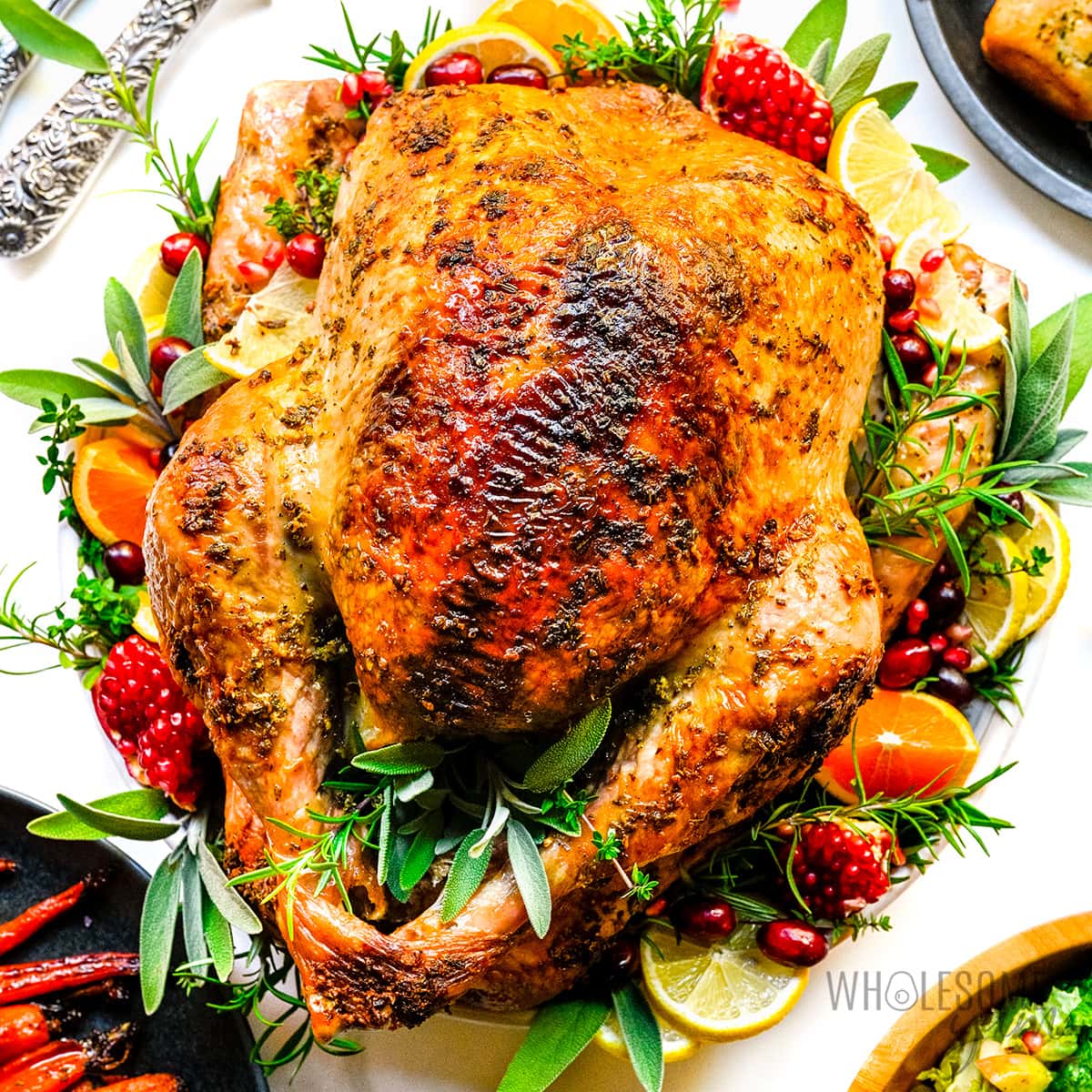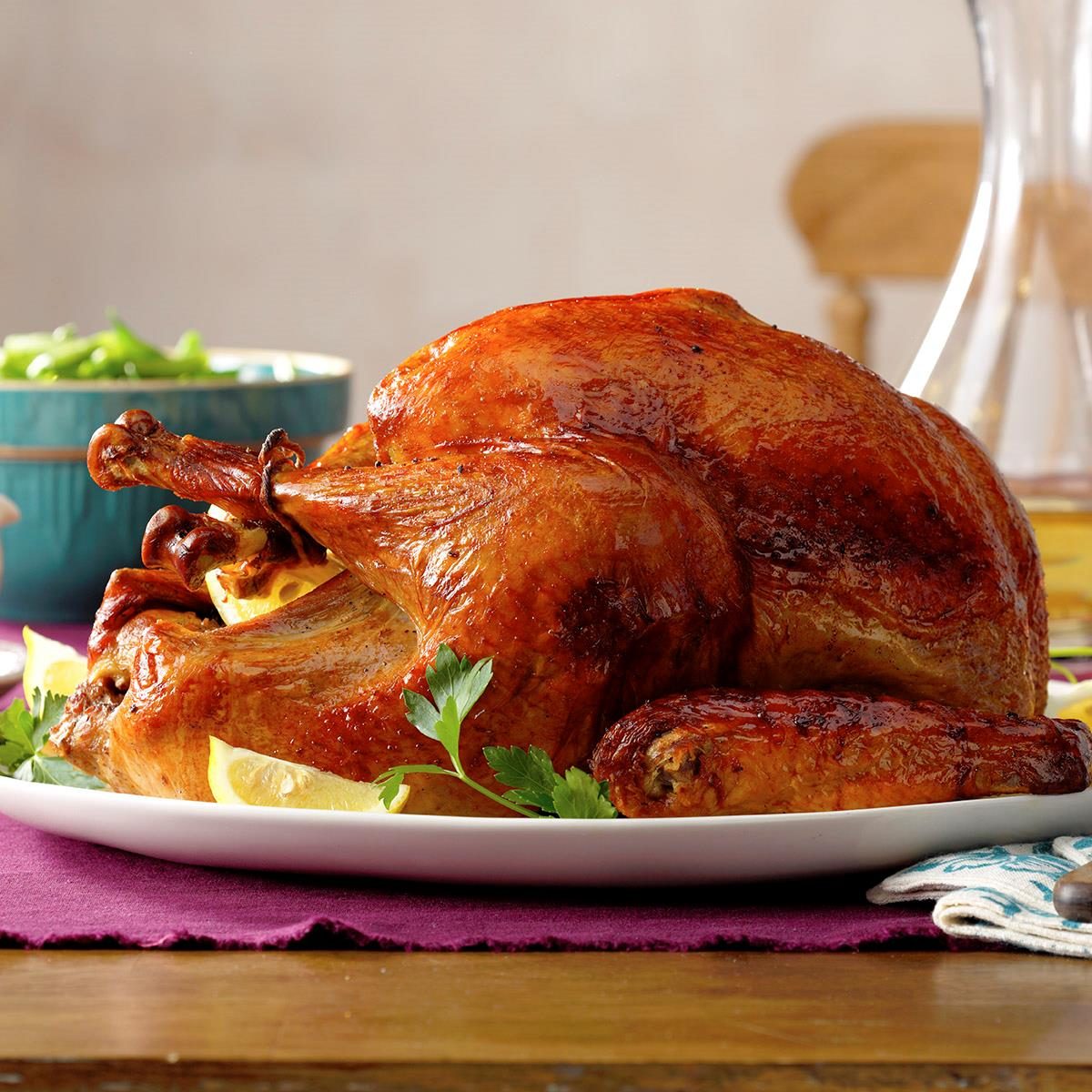As the autumn leaves dance in vibrant hues, the aroma of roasted turkey fills the air, signaling the arrival of Thanksgiving, a time for family, friends, and culinary delights. The centerpiece of this beloved holiday is undoubtedly the succulent turkey, a culinary canvas upon which we paint flavors and traditions.
In this comprehensive guide, we will embark on a gastronomic journey, exploring the art of preparing the perfect Thanksgiving turkey. From selecting the finest ingredients to mastering the techniques of brining, seasoning, and roasting, we will unravel the secrets to creating a centerpiece that will tantalize taste buds and leave lasting memories.
Thanksgiving Turkey Recipe Ingredients
Prepare a delectable Thanksgiving turkey by gathering the following essential ingredients:
The star of the show, a 12-14 pound fresh or frozen turkey, will provide ample servings for your guests.
Turkey
- 12-14 pound fresh or frozen turkey
Butter and Herbs
Elevate the turkey’s flavor with a generous amount of butter. One cup of unsalted butter, softened to room temperature, will ensure a juicy and flavorful bird.
Fresh herbs add a touch of aromatic complexity. Chop 1 tablespoon each of fresh sage, thyme, and rosemary.
- 1 cup unsalted butter, softened
- 1 tablespoon fresh sage, chopped
- 1 tablespoon fresh thyme, chopped
- 1 tablespoon fresh rosemary, chopped
Seasonings and Spices
A blend of seasonings and spices will enhance the turkey’s natural flavors. One teaspoon each of salt, black pepper, and poultry seasoning will create a savory and well-rounded taste.
- 1 teaspoon salt
- 1 teaspoon black pepper
- 1 teaspoon poultry seasoning
Vegetables and Aromatics
For a flavorful stuffing, chop 1 medium onion and 2 stalks of celery. A handful of fresh parsley, chopped, will add a touch of freshness.
- 1 medium onion, chopped
- 2 stalks of celery, chopped
- 1/2 cup fresh parsley, chopped
Broth and Bread
One cup of chicken broth will add moisture to the stuffing. Use 1 cup of dry bread crumbs for a classic texture.
- 1 cup chicken broth
- 1 cup dry bread crumbs
Turkey Preparation and Brining
Preparing the turkey before roasting ensures it cooks evenly and retains its flavor. Before seasoning and roasting, follow these steps:
- Remove the giblets, which are usually found in a bag inside the cavity. Discard or save for other uses.
- Rinse the turkey cavity and neck thoroughly with cold water. This removes any remaining blood or debris.
- Pat the turkey dry inside and out with paper towels. A dry surface helps seasonings adhere and promotes even browning.
Brining the turkey enhances its flavor and moisture. Two main methods are:
- Wet Brining: Submerge the turkey in a saltwater solution for several hours or overnight. This method distributes moisture evenly throughout the meat.
- Dry Brining: Apply a dry rub of salt and seasonings directly to the turkey. The salt draws out moisture from the turkey, creating a flavorful brine on the surface.
For wet brining, use a ratio of 1 gallon of water to 1 cup of salt. Dissolve the salt in cold water and add the turkey. Refrigerate for 12-24 hours, turning the turkey occasionally. For dry brining, apply the salt and seasonings to the turkey and refrigerate uncovered for 24-48 hours.
Remove the turkey from the brine or rub and pat dry before roasting.
Seasoning and Roasting the Turkey
Seasoning and roasting the turkey is crucial for achieving a flavorful and evenly cooked dish. Begin by patting the turkey dry with paper towels to remove excess moisture.
Generously season the turkey inside and out with a combination of herbs, spices, and salt and pepper. Some popular options include rosemary, thyme, sage, garlic powder, onion powder, paprika, and cayenne pepper. You can also use your favorite store-bought poultry seasoning.
Roasting the Turkey
Preheat the oven to 450°F (230°C). Place the turkey on a roasting rack in a large roasting pan. Brush the turkey with melted butter or olive oil to help the skin crisp.
Roast the turkey for 30 minutes at 450°F (230°C) to brown the skin. Reduce the oven temperature to 325°F (160°C) and continue roasting for an additional 2-3 hours, or until the internal temperature of the turkey reaches 165°F (74°C) when measured with a meat thermometer inserted into the thickest part of the thigh.
To ensure even cooking, baste the turkey with its own juices every 30-45 minutes. You can also cover the turkey loosely with aluminum foil during the last hour of roasting to prevent the skin from burning.
Stuffing and Side Dishes
Completing the Thanksgiving feast, stuffing and side dishes are essential accompaniments to the roasted turkey. Traditional stuffing recipes offer a blend of herbs, vegetables, and bread, while variations cater to different flavors and dietary preferences.
Popular side dishes that complement the turkey include mashed potatoes, gravy, and cranberry sauce. Each of these dishes offers a distinct taste and texture, adding to the overall culinary experience.
Traditional Stuffing Recipes
Classic stuffing recipes often include ingredients like celery, onion, sage, thyme, and parsley, along with bread cubes or croutons. Variations on this traditional recipe can incorporate other vegetables, such as carrots, mushrooms, or leeks, as well as different herbs and spices.
- Herb-Roasted Stuffing: A flavorful stuffing featuring a blend of fresh herbs, roasted vegetables, and bread cubes.
- Sausage and Apple Stuffing: A savory twist on traditional stuffing, incorporating ground sausage and diced apples.
- Cornbread Stuffing: A Southern-inspired stuffing using cornbread cubes instead of bread.
Side Dishes
Mashed potatoes, gravy, and cranberry sauce are staple side dishes for Thanksgiving dinner.
- Mashed Potatoes: Creamy and indulgent, mashed potatoes can be prepared with butter, milk, and seasonings, or enhanced with roasted garlic, herbs, or cheese.
- Gravy: A rich and flavorful sauce made from the turkey drippings, gravy adds moisture and depth of flavor to the meal.
- Cranberry Sauce: A tangy and refreshing accompaniment, cranberry sauce can be prepared with fresh or frozen cranberries, sugar, and spices.
Carving and Serving the Turkey

Once the turkey is cooked, let it rest for at least 30 minutes before carving. This will allow the juices to redistribute, resulting in a more tender and flavorful turkey.
To carve the turkey, start by slicing the breast. Use a sharp knife to cut thin slices, slicing against the grain. Once you have sliced the breast, you can remove the thighs and legs. To do this, use a knife to cut around the joint where the thigh meets the body.
Then, use a knife to cut around the joint where the leg meets the thigh. Once the thighs and legs are removed, you can slice them into pieces.
Garnishing and Presenting the Turkey
Once the turkey is carved, you can garnish it with fresh herbs, such as rosemary, thyme, or sage. You can also add some vegetables, such as roasted carrots or green beans, to the platter. To make the turkey look more festive, you can also add some cranberries or pomegranate seeds.
Last Point

As you gather around the table with loved ones, let the golden-brown turkey take center stage, its succulent meat melting in your mouth with every bite. May this Thanksgiving turkey recipe guide you towards a culinary triumph, a testament to the joy and abundance of this special day.
Helpful Answers
Can I use a frozen turkey for this recipe?
Yes, you can use a frozen turkey. Allow ample time for thawing in the refrigerator before cooking.
How do I ensure my turkey is cooked evenly?
Use a meat thermometer to check the internal temperature. The turkey is cooked when the thickest part of the thigh reaches 165°F.
What is the best way to season the turkey?
Generously season the turkey inside and out with your favorite herbs and spices. Allow it to rest for at least 30 minutes before roasting to enhance flavor absorption.
